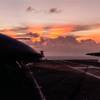The USS Oscar Austin (DDG 79), the first of the Arleigh Burke Flight 2A Aegis destroyers and the 17th Bath Iron Works-built, was commissioned in Norfolk Naval Station on Saturday August 19, 2000. Ship sponsor Dianne Reason, wife of retired admiral Paul Reason, brought the ship to life. Retired Rear Admiral Wayne E. Meyer, father of Aegis, conducted the tradition of the passing of the Long glass to the first officer of the watch.
The Flight 2A is a variant of the Burke class. It has full-up helo facilities, carrying up to two SH-60B Seahawk helicopters. The destroyer's first commanding officer is Commander Paul C. Smith USN and Executive officer Lieutenant Commander Thomas F. Schwarz USN. This magnificent ship, the 56th Aegis combatant, is named to honor marine Private First Class Oscar Palmer Austin.
Private first Class Austin was killed near Da Nang, South Vietnam on February 23, 1969, when he sacrificed his own life to save an injured companion. His act has been recognized with medals and decorations, which include the Purple Heart, the National Defense Medal, the Vietnam Service Medal with two bronze stars, the Republic of Vietnam Campaign Medal, and the Congressional Medal of Honor.
Oscar Austin was born January 15, 1948 in Nacogdoches, Texas and was raised in Phoenix, Ariz., where he joined the U.S. Marine Corps in April of 1968. Six months later, he was promoted to Private First Class and was transferred to the Republic of Vietnam where he served as Ammunitions Officer with Company "E", Second Battalion, Seventh Marine, First Marine Division (Rein), FMF.
During the early morning hours on February 23, Pfc. Austin's observation post was subjected to a fierce ground attack by a large North Vietnamese Army force using a heavy volume of hand-grenades, satchel charges and small arms fire. Observing that one of his wounded companions had fallen unconscious in a position dangerously exposed to hostile fire, Pfc. Austin unhesitatingly left the security of his fighting hole, and with complete disregard for his own safety, raced across the fire-swept terrain to assist the marine to a covered location. As he neared the casualty, he observed an enemy grenade land nearby and leaped between the injured marine and the lethal object, absorbing the effects of its detonation. Ignoring his own painful injuries, he turned to examine the wounded man and saw a North Vietnamese Army soldier aiming a weapon at his unconscious companion. With full knowledge of the probable consequences, Pfc. Austin threw himself between the casualty and the hostile soldier. In doing so, he was mortally wounded.
Featured videos

Tracking Foreign Vessels Working in the U.S. Jones Act Market

Inmarsat Enhances Service to Drive Digitalization

Inside the Electrified Truckable Tug
Subscribe for
Maritime Reporter E-News
Maritime Reporter E-News is the maritime industry's largest circulation and most authoritative ENews Service, delivered to your Email five times per week









